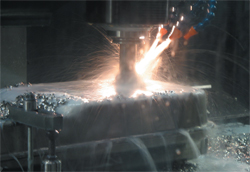
PROWAVE VERMICULITE PROCESSING SYSTEM
e2v Technologies, National Centre for Industrial Microwave Processing at Nottingham University, The Vermiculite Association
Used extensively in fireproofing, insulation and in horticulture, vermiculite is a naturally occurring clay consisting of a series of layers of mineral platelets. In its natural state, however, it doesn’t have the properties that make it so useful. These are generated by heating the clay up, which forces it to expand into a high-volume, low-weight form – a process called exfoliation.
This process is highly energyintensive, usually carried out in gas- or oil-fired furnaces that consume around 1MW/hr of energy per tonne of vermiculite. But a team from Essex-based e2v Technologies has exploited a quirk of the material to come up with a new, lower-energy process.
It’s been known for more than 20 years that vermiculite would also exfoliate when microwaved. However, despite a great deal of research, nobody has ever been able to turn this property into a workable industrial process.
Working with the National Centre for Industrial Microwave Processing at Nottingham University, e2v, which is itself a leading microwave-power design consultancy, developed a system that could cope with the natural variation of mined vermiculite. As it comes out of the ground, the material can have radically different moisture content, platelet thickness and particle-size distribution. The team’s system works by applying
microwaves to the underside of the vermiculite, only heating the water between the layers of material, forcing the platelets apart and causing the material to expand by up to 12,000 per cent. This drives out water vapour and dust, which is collected from above. The system includes digital control to fine-tune the application of energy; a microwave-transparent folding belt; and a solid-state 100kW power supply. The partners claim that this process reduces energy consumption by 90 per cent and cuts the carbon footprint of the process by 85 per cent.
SUSTAINABLE JOINING TECHNOLOGY FOR ELECTRIC MOTORS
Oxford YASA Motors, Oxford Brookes University
Oxford YASA Motors is a new spin-out company aiming to commercialise research from Oxford Brookes University into directdrive motors for electric cars, located in the wheel hub. The compact design of the motors has attracted interest from several EV pioneers, drawn to the possibilities of powerful, lightweight, high-torque motors that could provide a powerful form of propulsion for anything from performance cars to city runabouts. However, the company has had to design a manufacturing process to make the motors into a practical proposition.
YASA’s motors use new thermoplastic engineering polymers, fibre composites and adhesives to form an object that will experience large torques and tensile strains.
The team has experience with joining metals with composites, but needed to come up with a process that could use injection moulding to produce the motors. It had to cut assembly times from three days to a few hours; reduce materials costs by at least a factor of 10; and cut the production cost of a single motor from £3,000 to £500.
The firm has received funding from the Knowledge Transfer Partnership to tackle the problem and is working with Oxford Brookes to further develop the motors. The aim is to create one robust enough to survive the driving cycles encountered in the toughest environments, such as Northern Europe and Indonesia, while still reaching the massproduction cost and productivity targets.
F-35 MACHINING FACILITY
BAE Systems, Christal Management, BAM, D&S Engineering, StarragHeckert, Fastems, TDM, Nederman, Mayfran
The F-35 Lightning II aircraft, more commonly known as Joint Strike Fighter, could well be the world’s largest-ever military aircraft programme. The UK’s expertise in machining hard metals, specifically titanium, was an important factor in a significant proportion of the manufacture of the aircraft being located here, at BAE Systems’ manufacturing facility in Samlesbury, Lancashire.
The company has built a 10,000m2 Ti component-manufacturing facility to cope with the demands of the programme.
The project involves eight partners apart from BAE Systems itself, whose expertise ranges from civil engineering to machine building, specialist cutting tools, process management and swarf removal. The building has been designed to have as low a carbon footprint as possible, with minimal maintenance required and maximum floorspace flexibility. It also incorporates several ’world firsts’, including intelligent systems for coolant management and swarf handling; integral foundations; and automated on-machine boring systems.
The project has cost a total of 100m, of which £24m was construction cost and £66m equipment costs. Since opening last October, the facility has received several visits from BAE’s main partner in the F-35 roject, Lockheed Martin, which has declared it ’best in class’.





Red Bull makes hydrogen fuel cell play with AVL
Formula 1 is an anachronistic anomaly where its only cutting edge is in engine development. The rules prohibit any real innovation and there would be...